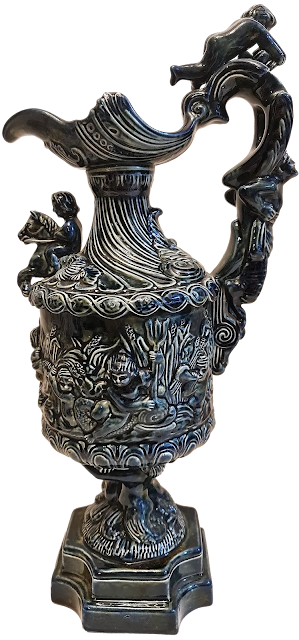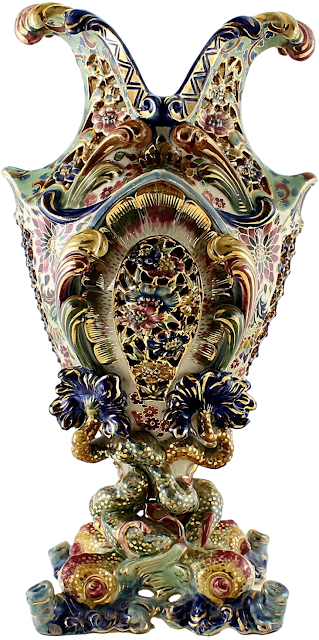The story of Fischer majolica begins at one of the most celebrated porcelain factories in Europe—Herend Porcelain. Founded by Vince Stingel, Herend was purchased in 1839 by Mór Fischer.
Ignác Fischer, born 1840, learned the pottery business at his father, Mózes Arom Fischer’s, small pottery in Tata-Tóváres. He then moved to Budapest to work at Herend, owned by a relative, Mór Fischer. There he learned the process of manufacturing porcelain as well as the business end of running a pottery. In 1864, Ignác left Herend and established his own pottery in Pest, Hungary.
Established as Fischer Ignác Porcelain, the company grew quickly. Three years later the company became a major pottery to rival Zsolnay, Hungary’s largest potter, creating porcelain dinnerware, terra cotta and earthenware decorative pieces for the home and garden. He was particularly known for his large majolica output.
The Hungarian majolica of Fischer is very different in look and character from traditional Western majolica. Instead of deeply molded areas covered with color like that used in France, England and Germany, the colored glaze is applied over a lead base through the freehand drawing of designs and highlighting of areas by talented paintresses. A porcelain base was used for some of the wares, unlike the earthenware of most majolica manufacturers. The tube lined technique used extensively in the West in the production of tiles is a commonly used technique. The application of gold trim. transfer decoration and enamels is also very common. Puzzle jugs and highly ornamental pieces in the Austrio-Hungarian, Turkish and Chinese styles made up the bulk of his ornamental wares. Their decorative approach is often compared to that of Zsolnay.
Fischer’s participation in international exhibitions like the Hungarian Exposition of 1885 and Paris Exhibition of 1889 brought fame to the company particularly through their Chinese influenced designs. Through these shows Fischer majolica developed a large audience throughout the Austrio-Hungarian empire. In time Fischer’s factory found itself exporting a percentage of his product to the United States. This was the work of Igánáz Fischer’s son Emil who handled the company export business.
By 1885 the aging Ignác handed the bulk of the company’s management to his son Emil (b.1852) who wasn’t as successful as his father in running the business. The decline in the business’ fortunes forced Emil to sell the operation to Zsolnay in 1895 putting an end to Fischer Ignác Porcelain. Ignác died at the age of 66 on April 13, 1906.
Emil went on to open another pottery which specialized in Art Nouveau pottery and remained in business until the start of the first World War. He then went on to partner with the owner of the Hólloházi Stoneware Factory which manufactured more utilitarian wares. The partnership lasted until the end of 1945.
Fischer pottery is usually marked with a plain ink mark, FISCHER J. BUDAPEST. They also used an impressed mark. After 1890 they also used a more elaborate mark using a lion head above a shield. Emil Fischer used a stylized ink mark with his initials EF HUNGARY.





























No comments:
Post a Comment